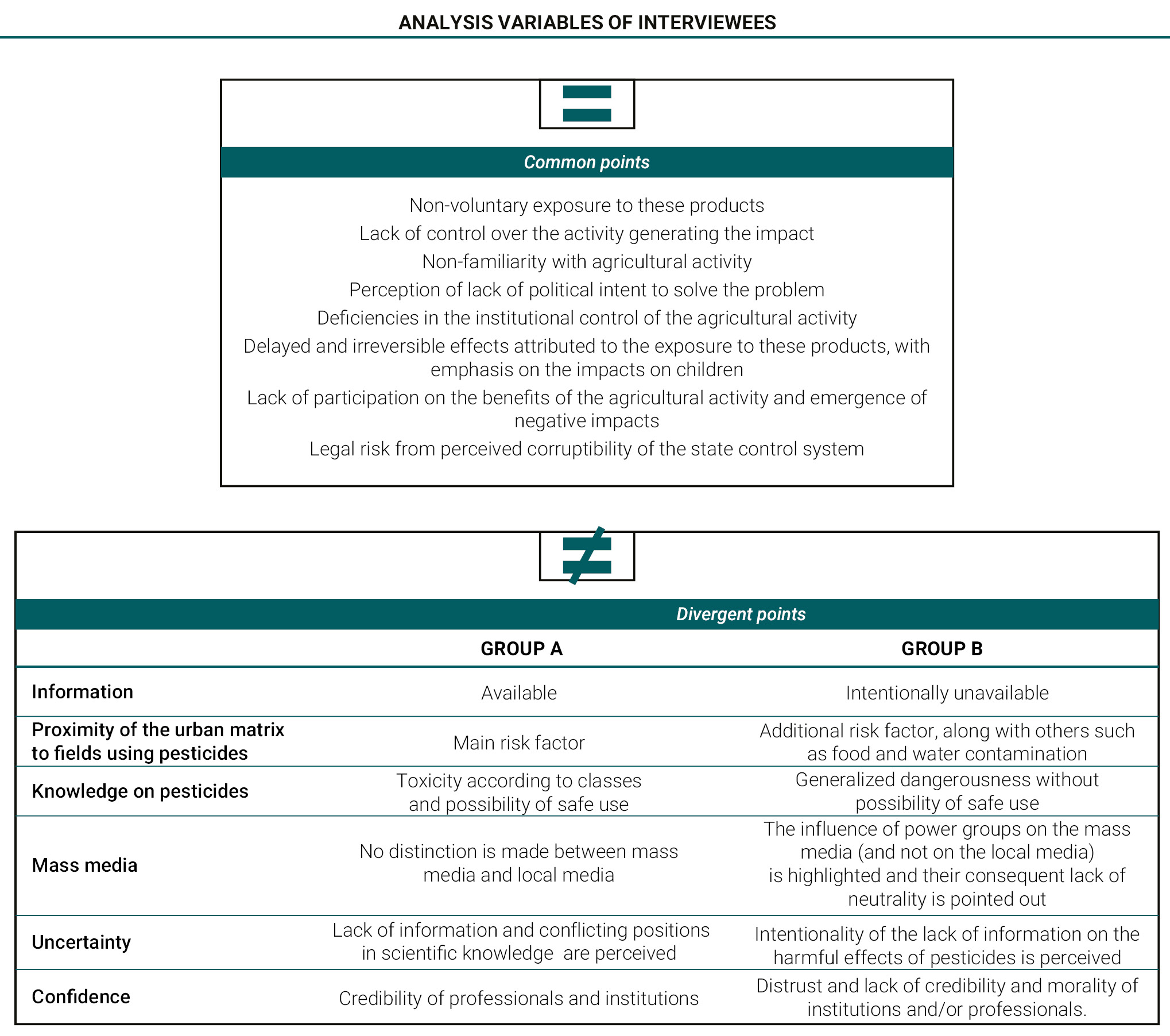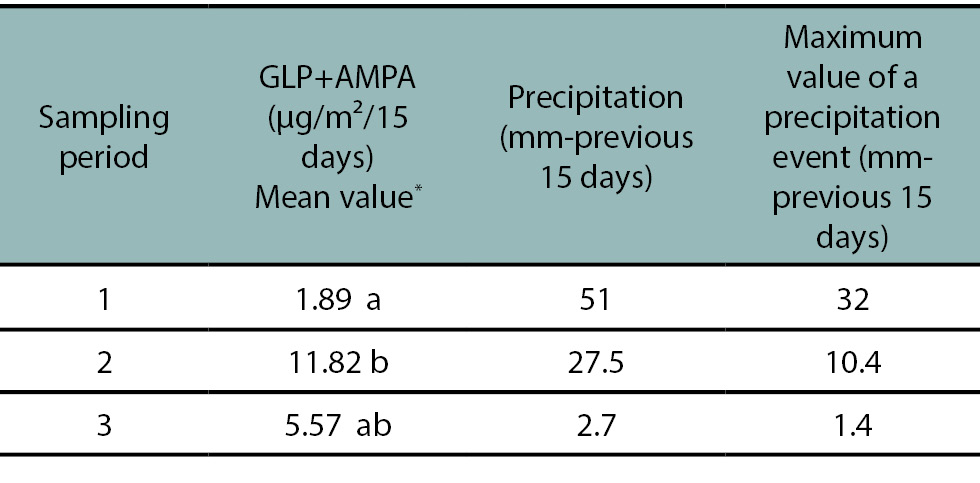INTRODUCTION
In recent years, agricultural production in Argentina, with a marked predominance of soybean, has increased both in terms of cultivated area and yield (Aizen et al., 2009). The province of Entre Ríos, in northeastern Argentina, has followed the same trend, with increases of about 180% in soybean planted area and of 165% in soybean production between the 2000/2001 and 2021/2022 campaigns (BOLSACER, 2023). This scenario is characterized by an increase in the amounts of agrochemicals used, mainly herbicides (Sasal et al., 2017). Regarding this, Montoya et al. (2022) reported increases in the use of phytosanitary products from 151 million L or Kg in 2002 to 373 million L or Kg in 2022. Among the products recorded, herbicides are the majority group (43% in 2022) and glyphosate [N (phosphonomethyl)glycine: GLP] stands out as the main commercial pesticide, mainly associated with genetically modified organisms, comprising 62% of the total agrochemicals marketed in 2014 (CASAFE, 2014).
In parallel, the society is increasingly concerned, and disputes are growing over the environmental, social, economic, and territorial impacts of agricultural production, as well as of the increase in deforestation, the use of monocultures, and the new associated technologies, including pesticides and genetically modified seeds (Reboratti, 2010). Pesticides represent one of the main sources of diffuse environmental contamination (Andrade et al., 2017). In Argentina, their presence has been detected in the air, soil, surface and groundwater, and food (Alonso et al., 2018; Astoviza et al., 2015; Caprile et al., 2019; Lorenzatti et al., 2008; Primost et al., 2017; Sasal et al., 2017; Villaamil Lepori et al., 2013). Given these situations, the social participation in scientific-political processes should be analyzed (Funtowicz and Ravetz, 2000), incorporating factors such as risk perception, uncertainty and trust in regulatory decision-making on pesticides (Van Straalen and Legler, 2018). However, research on this subject is recent and still scarce.
In social sciences, most studies have addressed the perception of actors directly linked to the use or application of pesticides (agricultural producers, rural workers, technicians, etc.) as opposed to that of the rest of the population or of those identified as “affected” by their use. These studies agree on the complexity of conflicts in peri-urban areas and on the different perceptions that co-exist in this regard (Ahmed et al., 2011; Cloquell et al., 2011; Diez, 2016; Feito, 2011; Giordano et al., 2018; Sullivan et al., 2004). In general, these perceptions differ depending on whether the actors are involved in the agricultural sector or not (mainly because of their occupation), a fact that determines the various solutions that may be proposed to address the problem. In recent years, these conflicts have become particularly relevant in peri-urban areas where residential areas are close to the sites where agrochemicals are applied, questioning the risks to which the nearby populations would be exposed (Pérez et al., 2013), and emphasizing the use and impacts of glyphosate (Moltoni, 2020). In these urban-rural interface areas, the drift of pesticide spraying has been pointed out as a cause of contamination and air quality deterioration (Cloquell, 2011; Jäger et al., 2016; Souza Casadinho, 2013).
In contrast to what has been observed in other environmental compartments, studies addressing the air matrix are scarce. Some researchers have stated that both during and after applications, a relatively substantial fraction of pesticides can be entered into the atmosphere as “drift” (Van den Berg et al., 1999). In general, the quantified drift is that produced at the time of application or subsequent minutes and that so-called “direct”, that is, the aqueous phase generally transported by the action of wind outside the treatment area. However, losses can also occur in other phases (vapors, aerosols, adhesion to solid particles) and even hours or days later, constituting the so-called “indirect” drift. This drift, together with the “direct” drift, represents the main path of pesticides to the atmosphere (Epple et al., 2002). The physicochemical characteristics of the active substance and the environmental conditions with which it interacts will determine its transport and destination (Loewy, 2011).
These substances can return to the surface through atmospheric deposition (Vogel et al., 2008), a process by which air particles and gases are deposited on earth’s surface, through two mechanisms: wet deposition (by the action of precipitation) and dry deposition (by the action of gravity or by impact on surfaces) (Waite et al., 2005). Thus, sampling and characterization of total atmospheric deposition are relevant to identify the variability and sources of air pollutants (Azimi et al., 2005) and are valid to evaluate environmental loads (UNEP, 2007).
Regarding studies that have analyzed pesticides in atmospheric deposition, only few have considered glyphosate (GLP) and its main degradation product aminomethylphosphonic acid (AMPA). These studies have concluded that both GLP and AMPA are dominant over other pesticides analyzed (Majewski et al., 2000; Farenhorst et al., 2015). It is worth mentioning that they are associated with solid particles and not to the gaseous state (Morshed et al., 2011). Regarding AMPA, different detection frequencies and maximum values have been reported, being in some cases similar to those of GLP and in other cases either lower or null (Majewski et al., 2000; Humpries et al., 2005; Chang et al., 2011; Andronak, 2013; Lamprea et al., 2011). In Argentina, Alonso et al. (2018) published the first work on the presence of herbicides (GLP and atrazine) in rainwater in the main agriculture provinces of the Pampas region (Buenos Aires, Entre Ríos, Santa Fe, and Córdoba). In general, all the aforementioned works show a clear relationship between the presence of GLP and the periods of greatest application, but not between sampling sites and the distance to agricultural areas or distances between land uses (urban/rural).
The present work was performed in the locality of Oro Verde, in the province of Entre Ríos, and was structured according to the following aims: (i) to analyze the perception of the inhabitants of the urban matrix regarding the use of agricultural pesticides in urban-rural interface areas, and (ii) to identify spatial and temporal variations in the atmospheric deposition of GLP and AMPA.
MATERIALS AND METHODS
Study site
The methodology adopted was the case study (Yin, 1989), in which the study site considered was the town of Oro Verde (Entre Ríos, Argentina) (fig. 1). This town experiences the growth of both its urban matrix and of the peripheral settlements that are close to the rural area, a fact that results in tensions and conflicts between the activities characteristic of both land uses. In 2014, municipal norms regulating the use of pesticides were sanctioned as a result of the growing claims of the population (nº 0041/2014). The most important points of these norms were the prohibition of aerial spraying in the locality and the creation of a protection zone where terrestrial spraying of pesticides is prohibited. This area includes the urban area and a radius of 300 meters (considering schools, natural reserves, and watercourses).
The climate in Oro Verde is temperate humid without dry season with a mean annual daily temperature of 18.8°C and mean annual precipitations of 1102 mm, distributed throughout the year, although higher in October-April (spring-summer) (Wingeyer et al., 2023).
The town has an area of 4400 ha and 5192 inhabitants (Municipal Census of Population, Homes and Housing of Oro Verde 2013). Its population is mainly urban (97%) and is distributed in three areas: Central, South and Triangular (fig. 1). Within the locality, there is coexistence and proximity between residential and agricultural lands, as well as new lands for sale already delimited in rural areas or close to them.
Methodological strategy
The research was conducted between 2016 and 2018 and had an exploratory-descriptive design and a mixed methodological strategy with qualitative and quantitative strategies. To analyze the perception of the inhabitants of the urban matrix regarding the use of agricultural pesticides in urban-rural interface areas, surveys were conducted among people over 18 years of age. A stratified probabilistic sample of 358 people (5% error, 95% confidence level, and 50% response distribution), was performed. A random selection of blocks and houses was used to guarantee that all elements of the population had the same probability of being chosen to integrate the sample (Sampieri et al., 2010). In addition, in-depth interviews of the inhabitants who expressed feeling affected by the use of pesticides in agricultural fields near their homes were conducted to analyze their perception of risk. For the design, variables proposed in Jäger et al. (2016), Vaccarezza (2015) and Covello and Sadman (2001) were taken into account (table 1).
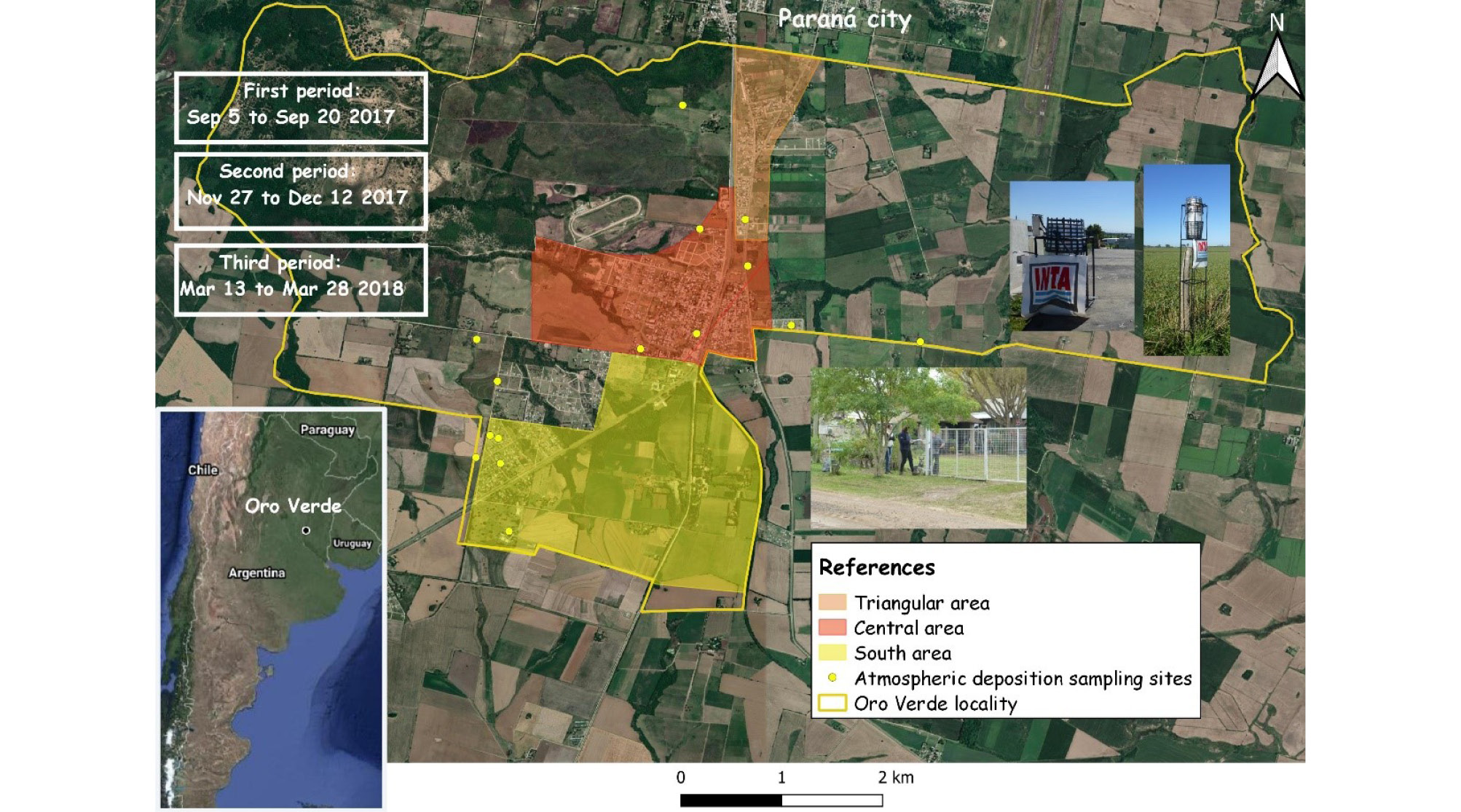
Figure 1.Study area, atmospheric deposition sampling sites, sampling periods and urban areas of the locality where surveys and interviews were carried out.
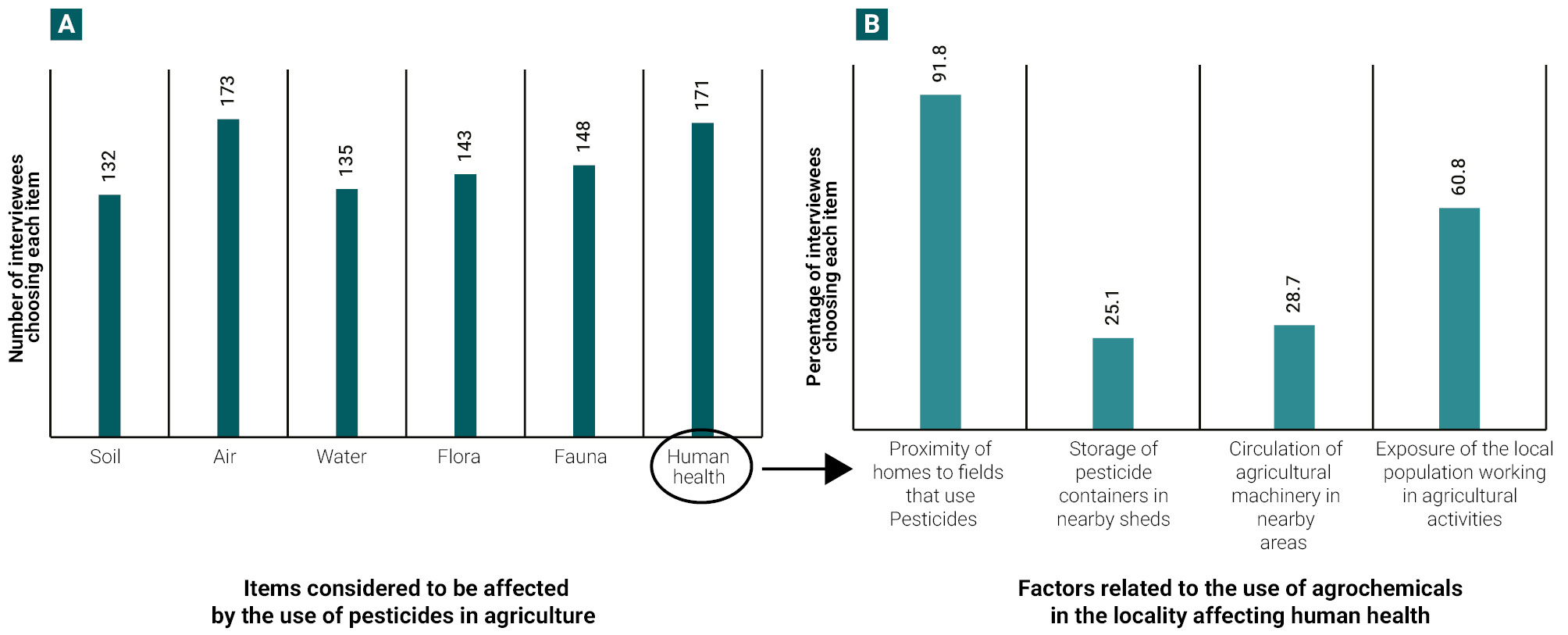
Table 1.Analysis of variables of the perception of environmental risk due to pesticide use. a, risks from activities viewed by people as activities that may place them or their families personally and directly at risk (e.g., living near a waste disposal site) are judged to be greater than risks from activities that appear to pose no direct or personal threat (e.g., disposal of waste in remote areas) (Covello and Sadman, 2001).
The sampling was non-probabilistic and considered neighbors’ complaints and articles in local media. The “snowball” technique was used to determine the total number of interviewees, until theoretical saturation was achieved (Guber, 2004).
To identify spatial and temporal variations of GLP and AMPA in atmospheric deposition, both compounds were analyzed in total atmospheric deposition samples (dry + wet) from Oro Verde, following the ASTM D 1739:98 standard test method and consulting published studies (Humphries et al., 2005; Andronak, 2013; Farenhorst et al., 2015; Epple et al., 2002; Teil et al., 2004). To analyze spatial variations, 15 sites were selected according to their distance to agricultural plots, covering urban, rural and urban-rural areas. In order to examine temporal variations, three sampling periods were chosen, as proposed in Sasal et al. (2017) for the province of Entre Ríos: a first period (from September 5 to 20, 2017) associated with GLP applications in the chemical-fallow period prior to the cultivation of premium soybean; a second period (from November 27 to December 12, 2017) associated with GLP applications during pre- and post-emergence; and a third period (from March 13 to 28, 2018) away from GLP application dates, after soybean harvest (fig. 1).
The sampling devices used were conditioned and washed following the standards established by the Pesticide Analysis Laboratory of the Center for Environmental Research (CIM-CONICET) of the National University of La Plata (Buenos Aires, Argentina). A total of 100 µg of bactericide (NaN3) was attached to each device to prevent the degradation of compounds by microorganisms (Epple et al., 2002). At the end of each sampling period, the presence of liquid in each device and its volume were recorded.
Total solids[1] (TS), vertical mass flow, and total suspended solids[2] (TSS) were then calculated. GLP and AMPA were determined in the Pesticide Analysis Laboratory of the CIM-CONICET through extraction with active solvents for subsequent quantitative chemical determination of GLP and AMPA by high-performance liquid chromatography coupled to mass spectrometry (HPLC-MS), as described by Alonso et al. (2018).
1Matter that remains as a residue after evaporation and drying at 103-105 °C and includes dissolved (soluble) and non-dissolved (particulate) materials.
2Matter retained in a fiberglass filter with a nominal pore size of 0.45 microns.
Data analysis
Perception surveys: The perception surveys were analyzed by means of descriptive statistics and a non-parametric test (Chi square test) to analyze associations between nominal variables that did not follow a normal distribution (Sampieri et al., 2010; Arriaza Balmón, 2006) through the use of INFOSTAT™ software.
In-depth interviews: The in-depth interviews were analyzed using content analysis methodology, taking into account the variables specified in table 1. Some of them were used to characterize the perception of environmental risk due to the use of agrochemicals, whereas others were used to analyze the study problem according to general factors of public perception of risks by applying them for this particular case.
Atmospheric deposition: The atmospheric deposition was analyzed by descriptive statistics and temporal and spatial variations in GLP and AMPA quantities were explored using nonparametric Kruskal-Wallis test after checking for non-normal distribution. Also, exploratory multivariate analysis was performed to assess differences between sampling sites. Spearman’s correlation was used to determine correlations between quantitative and descriptive variables. INFOSTAT™ software was used. Meteorological data of each sampling period were obtained from the agrometeorological station of the Estación Experimental Agropecuaria Paraná of the Instituto Nacional de Tecnología Agropecuaria (EEA-INTA Paraná). Maps were constructed using QGIS v.3.2.0 software.
RESULTS
Perception surveys
Most of the population inhabitants surveyed (98%) were permanent residents of the town and female (63%). Regarding the level of education, 55% had reached tertiary/university level, whereas regarding their occupation, 71% worked and/or studied.
Similar to what has been previously reported (Ahmed et al., 2011), we found a relationship between the occupation of the interviewees and the identification of the research problem (*Chi square test). The identification of a problem in the locality linked to the use of pesticides was more common among inhabitants who did not have an agricultural-related occupation (work and/or study). This was even more important considering that only 16% of the interviewees had or had had an occupation related to agriculture.
At least 66% of the interviewees reported at least some problem related to the use of pesticides/agrochemicals in the locality, with the items “air” and “human health” (as affected items) with higher frequency of choice (fig. 2a). In addition, health impacts at the local level were mainly attributed to the factor “proximity of the urban matrix to fields using pesticides” (an item selected by 91.8% of the interviewees) (fig. 2b). Also, 39% were considered affected by the use of agricultural pesticides in the locality, and the item “air” was mentioned in 90% of all responses when researching possible routes of exposure.
As for the local ordinance that regulates the use of pesticides, only 22% were aware of its existence. Of these, 35% said they were unaware of its content and 36% said that it partially solved the problem in the locality.
Finally, our results showed a relationship between the occupation of the interviewees and the proposals to solve the problem. People with agricultural occupation identified proposals related to “good agricultural practices”[3], while those unrelated to this sector proposed changes in the production model towards agroecological systems, reduction and/or elimination of pesticide use, increased use of organic products, or increased buffer distances/buffer zones (*Chi square test).
3Compliance with current legislation (with current restriction distances), correct use of pesticides, greater control in applications.
In-depth interviews
The analysis of the general situation of the interviewees showed some points in common: they were new residents who had chosen the locality based on an idea of a “green/natural” area, less polluted and chaotic than the urban environment, but had later identified the applications of pesticides in fields surrounding their homes as a potential health risk. Their expectations thus contrasted with the situation encountered later and they constantly referred to “smell” as the indicator that alerted and mobilized them. The content analysis performed revealed both common and divergent points (fig. 3) regarding the analysis variables. The divergences may partly explain the different points of views found regarding the solution of the problem and the perception of risk.
These two identified positions with respect to some of the variables analyzed (separated in groups A and B in fig. 3) were related to the different proposals for the solution to the problem. The position identified as Group A made emphasis on the existing legislation on the subject and control of agrochemical applications (“good agricultural practices”), whereas that identified as Group B proposed a change in the production model and considered that the problem arises not only from the proximity between the urban matrix and agricultural plots, but also from other risk factors that are not being taken into account (exposure to pesticides via water consumption, food, etc.). Both positions agreed on the need for urban growth planning to prevent conflicts.
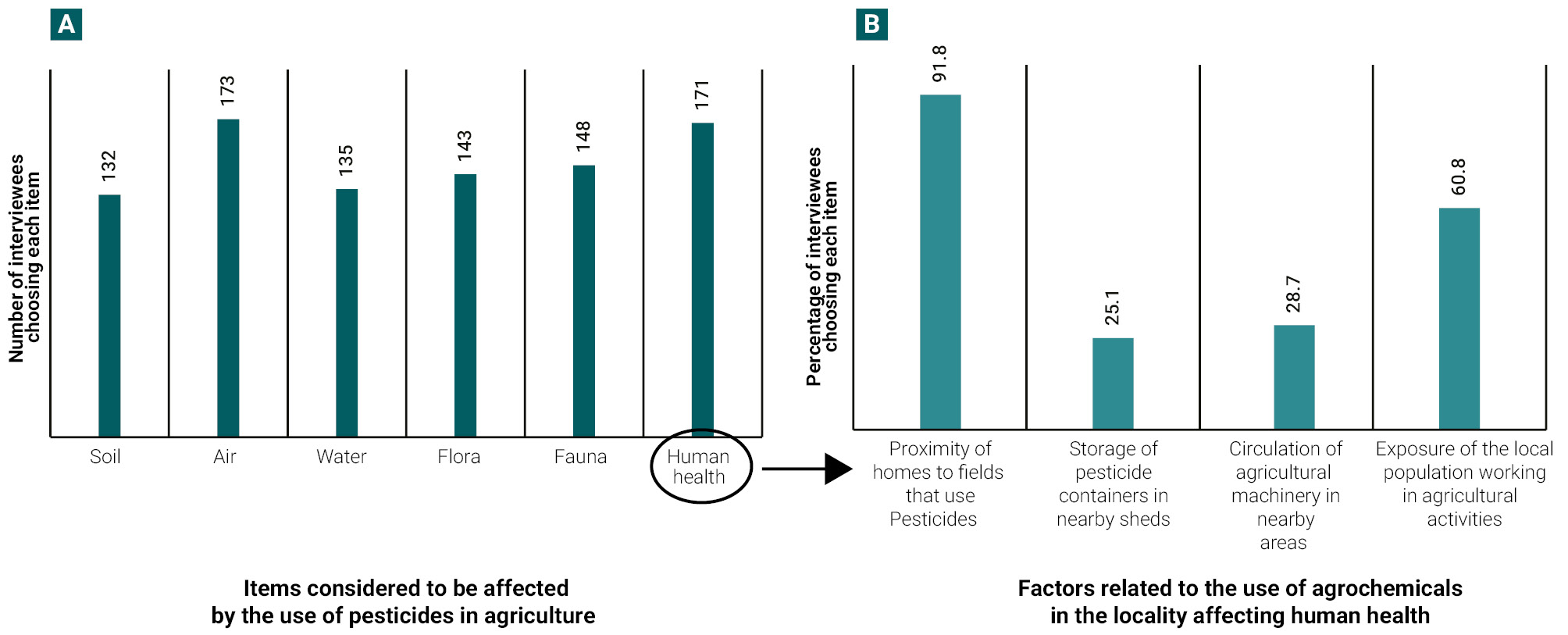
Figure 2.A) Items considered to be affected by the use of pesticides in agriculture (number of interviewees choosing each item); B) Factors related to the use of agrochemicals in the locality affecting human health (percentage of each factor).
Atmospheric deposition
The three sampling periods had varying weather conditions resulting in differences in the volume of liquid collected and the concentrations of TS and TSS (g/L) in the last two periods compared to the first (Table 2). Significant negative correlations (p ≥ 0.10) were found between TS (g/L) and TSS (g/L) and the volume collected (r-0.84 and -0.56, respectively).
Both GLP and/or AMPA were detected in all the sampling periods, but not in all the sampling sites (fig. 4). GLP and/or AMPA showed the highest detection frequency in the second sampling period, whereas AMPA showed a higher detection frequency than GLP in all the periods (24.4% and 17.78%, respectively). If we consider the compounds separately, more than 50% of the sampling sites showed no GLP detection in any of the sampling periods and the same was verified for AMPA. When considering both compounds together, 40% of the sampling sites showed no detection in any of the sampling periods.
After corroborating the non-normal distribution of the data, Kruskal-Wallis nonparametric test was applied to assess the differences between GLP and AMPA concentrations (µg/m²) in the sampling periods. The maximum value found in the first period was removed because it was an extreme value for the data range, associated with a direct drift from an herbicide application made 15 meters from the sampling device. Eliminating outlying values can allow a more adequate assessment of environmental conditions and a better analysis of the depositional contributions (Majewski et al., 2000).
The analysis showed higher amounts (µg/m²) of the analytes of interest in atmospheric deposition in the second sampling period (associated with pre- and post-emergence spraying events of soybean crops) than in the first (table 3). This was expected because, in the second period, the areas subject to GLP applications were larger than in the first period (because plots are intended for premium and second-rate soybean cultivation), and because, in contrast, in the first period, the applications were only associated with chemical fallow previous to premium soybean cultivation and thus the areas subject to GLP applications were smaller.
The GLP and AMPA values obtained during the third sampling period (which was”free of applications”) could be due to the climatic characteristics during the different periods (see below). Positive associations were found between the amounts of GLP+AMPA and the concentrations of TS (g/L) and TSS (g/L) (0.34 and 0.26, respectively), as opposed to a negative association with the volume of liquid collected (0.4). The higher precipitation in the first sampling period regarding the other two may have generated a “dilution effect” of the compounds in the sample. In contrast, the higher concentrations of TS and TSS in the second and third periods compared to the first could have influenced the amounts of GLP and AMPA present in the sample and their subsequent detection. In addition, the record of precipitation during the 15 days prior to the first sampling (table 3) showed that this period was preceded by higher rainfall and a larger precipitation event than the other two periods. Although the first sampling was a period of GLP applications, the precipitations prior and during the sampling may have led to atmospheric washing and subsequent dilution of contaminants within the sampling device. The third period was preceded by little rainfall, so, although less spraying of this herbicide was expected, the high concentrations of particles in the atmosphere may have led to the results obtained.
Finally, multivariate analysis was performed to assess differences among sampling sites according to their location (urban, rural, urban-rural interface) and to their distance from agricultural plots. The results showed no relationships among these variables.

Table 2.Mean temperature and precipitation in the three sampling periods considered. a,TS= total solids; b, TSS: total suspended solids.*Analysis of variance and LSD Fisher test for comparison of means (p ≥0.05); SD: standard deviation.

Figure 4.Frequency of detection of glyphosate and/or its metabolite aminomethylphosphonic acid (AMPA) for each sampling period and for all sampling periods (three periods).
DISCUSSION
Surveys and perception analysis
The two methodologies applied surveys and interviews made it possible to explain the population’s perception regarding the problem of pesticide applications in the locality of Oro Verde and to identify items related to pesticide use in urban-rural interface areas, such as “proximity to soybean fields”, as the main health risks.
Similar to that reported in previous studies in other peri-urban spaces (Cloquell, 2011; Feito, 2011; Sullivan et al., 2004), in the locality of Oro Verde, tension is a characteristic in which new inhabitants (generally urban) come into conflict with activities associated with rural life.
The variables surveyed in the interviews showed similarities with what was found by other authors (Giordano et al., 2018), especially regarding the perception of the absence of control by state agencies and the lack of political intention to solve the problem. The different positions in the conflict (the problem identified, the possible solutions, the elements affected) coincide with that reported by Jäger et al. (2016), who understand perception as an individual cognitive process of elaboration and interpretation of stimuli, where different preconceptions intervene and where knowledge, prejudice, lack of information, projections, etc. are combined.
The issue discussed in this study has also been assessed in other case studies. In the Argentine province of Misiones, Diez (2016) also identified two positions regarding the use of pesticides: a “conservative” position (rational model with a “good use” of pesticides) and a “transformative” position (with acute criticisms to the productivist model). In general, these positions are characterized by criticizing what is called “agribusiness” as a new agricultural model in Argentina, based, among other things, on the use of biotechnologies, technological innovation, and high capital requirements (Gras, 2013). In Oro Verde, this position was identified in group B. For them, the problem is the production model and therefore the solutions are not limited to, for example, the use of good agricultural practices or the increase in the distances between the populated areas and fields where pesticides are used. Accordingly, they had generally participated in organizations or social movements associated with environmental issues, because they looked for changes larger than specific actions in their neighborhood.
Herbicides in atmospheric matrices
The detection frequency of both GLP and AMPA in the present study was lower than that reported by Alonso (2018) in atmospheric wet deposition in the Pampas region, where the detection frequency was 81% for glyphosate and 34% for AMPA.
Internationally, the detection frequencies recorded are higher for GLP but lower for AMPA. In Canada, for example, Farenhorst et al. (2015) reported frequencies of 81% for GLP and 18% for AMPA, whereas Andronak (2013) reported values between 60 and 100% for GLP and between 6 and 18% for AMPA.
Regarding the values found (mass loads) in the bibliography, the published results are diverse, with values both higher (Alonso, 2018) and lower (Farenhorst et al., 2015; Humpries et al., 2005; Messing et al., 2011) than those found in this study. However, comparison is not recommended because the methodologies used in different studies are not strictly comparable or have point sources of emission of these compounds, which, in many cases, determine the maximum values found.
The analyses conducted here to identify temporal variations suggest that precipitation, which affects the concentration of particles in the atmosphere, may be a factor contributing to the changes in TS and TSS levels (measured in g/L) both during and before the sampling periods.
As previously discussed, significant rainfall previous to the sampling period can cause “washing of the atmosphere”, whereas precipitation occurring during the sampling may cause a dilution of the pesticides of interest within the sampling device. Chang et al. (2011) estimated that, on average, 97% of the GLP present in the atmosphere can be removed with a weekly rainfall of 30 mm, a situation that could have occurred with rains prior to the first sampling period of the present study. Previous reports have also highlighted the tendency of GLP for being adsorbed onto solid particles (and not for being in the gaseous state), a fact that results in dry deposition being an important component of total GLP deposition. This is attributable to its high organic carbon to water partition coefficient (Koc value) and low vapor pressure. In this regard, Farenhorst et al. (2015) found differences when analyzing GLP deposition in dry and wet periods, recording higher values in the former. Humpries et al. (2005) suggested that the GLP/precipitation ratio should be studied in greater detail, given that a survey in Canada found that the highest GLP deposition rate (1.26 µg/m2/day) was associated with significant precipitation after a 14-day period with precipitations of only 0.5 mm. Additionally, Farenhorst et al. (2015) suggested that GLP concentrations are likely the result of atmospheric dust and rain washing the particles rather than the herbicide dissolving in the particles that subsequently precipitate. Also, Morshed et al. (2011) suggested that the nature and concentration of particulate matter in the atmosphere could determine the GLP load, and that the number of dust particles in the air is reduced as a result of high atmospheric humidity and frequent precipitation events. This could explain the lower values of atmospheric deposition of GLP and AMPA found in the first sampling period of this study. A recent study by Alonso et al. (2018), which focused on the wet deposition of GLP and AMPA in Buenos Aires, Entre Ríos, Santa Fe and Córdoba provinces (Argentina), showed no differences between periods of greater and lesser application, but did find relations between precipitation dynamics and GLP and AMPA concentrations, with higher values in areas with lower annual cumulative precipitation values.
With regard to the lack of evidence of a relationship between the GLP and AMPA concentrations found in atmospheric deposition and the locations of the sampling sites, the distance to agricultural plots, or the prevailing winds, it is necessary to emphasize that Alonso et al. (2018) also found no relationship between the values of these compounds in rainwater and those in soils. It is possible to assume that, although soils are a source of exposure to these pesticides, other processes associated with atmospheric circulation are more important than the effect of the local use of pesticides (Alonso et al., 2018). Furthermore, Bento et al. (2017) observed that GLP and AMPA tend to adsorb onto finer soil particles smaller than 10 µm, which could increase their long-range airborne transport as particles smaller than 20 µm can remain suspended and are so prone to be transported over long distances. Therefore, further research is needed to understand the behavior of these compounds and their impact on areas adjacent to those where GLP is being used.
Finally, we highlight that a trend was found for the temporal variations (in the periods of higher or lesser application of the herbicide and precipitations), but not for the spatial variations.
CONCLUSIONS
This research contributes to analyzing the conflict associated with the use of agricultural pesticides in urban-rural interface areas, taking as a case study the locality of Oro Verde, in the province of Entre Ríos, Argentina. We consider that the methodological triangulation used was appropriate and allowed us not only to characterize the problem, but also to identify factors indicated by the population, analyzing different perceptions, and obtaining results of quantitative determinations of pollutants.
The results verified the detection of GLP and its metabolite AMPA in the air, which is consistent with that perceived by a large part of the population. However, we emphasize that comparison with air quality standards or guide levels was not possible, as they currently do not exist. Spatial variations could not be explained by the “proximity to agricultural areas”, a factor noted in the surveys and partly by interviewees as a major risk factor. However, the need for greater regulation controls based on usage restrictions (buffer zones) is evident due to concerns expressed by the population.
The results analyzed in this case study can be identified in many other localities with similar patterns, as processes of population growth and increasing (and dispersed) urbanization, which lead to scenarios of tension and conflict between residential and agricultural land use, especially in peri-urban spaces. The integration and analysis of the population’s points of view and environmental measurements are considered necessary to address socio-environmental problems and generate knowledge that can then contribute to local planning and development. Also, it would be interesting that these public policies can be approved by the population involved.
Finally, the results highlight the importance of assessing the diversity of perspectives in the face of a conflict as well as the importance of supplementing this information with quantitative assessments of the presence and impact of pesticides in the environment. Both analyzes are necessary to manage urban-rural conflict based on agrochemicals. The information generated should be complemented by studies linked to other disciplines such as health sciences.













